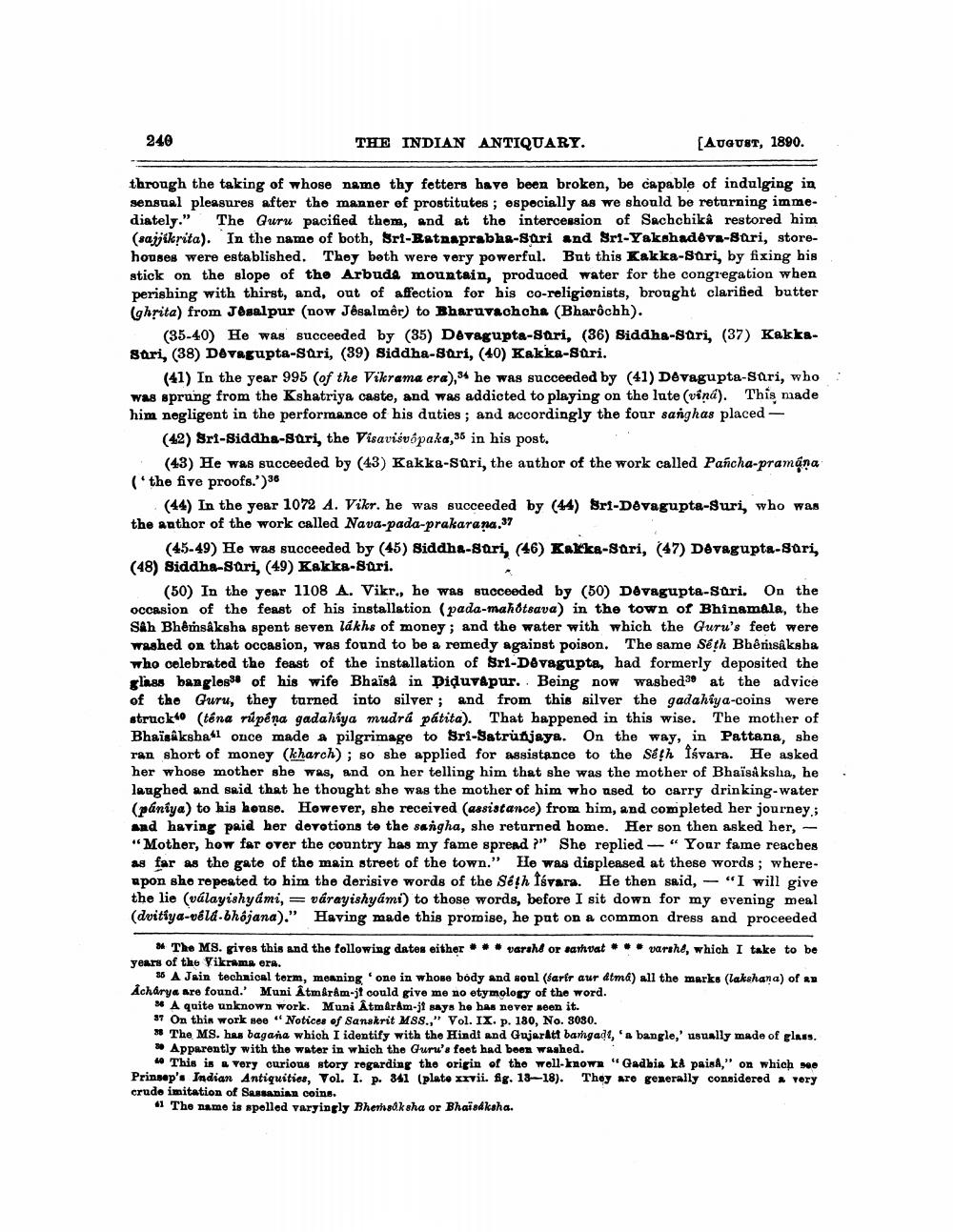________________
240
THE INDIAN ANTIQUARY.
[AUGUST, 1890.
throngh the taking of whose name thy fetters have been broken, be capable of indulging in sensual pleasures after the manner of prostitutes ; especially as we should be returning immediately." The Guru pacified them, and at the intercession of Sachchika restored him (sajikrita). In the name of both, Sri-Ratnaprable-sari and Sri-Yakshadova-Sari, storehouses were established. They both were very powerful. But this Kakka-Sari, by fixing his stick on the slope of the Arbuda mountain, produced water for the congregation when perishing with thirst, and, out of affection for his co-religionists, brought clarified butter (ghrita) from Jêsalpur (now Jêsalmer) to Bharuvachcha (Bharôchh).
(35-40) He was succeeded by (35) Dévagupta-sari, (36) Siddha-suri, (37) KakkaSari, (38) Dovagupta-Sari, (39) Siddha-Bari, (40) Kakka-Suri.
(41) In the year 995 (of the Vikrama era), 54 he was succeeded by (41) Devagupta-Sari, who. was sprung from the Kshatriya caste, and was addicted to playing on the lute (viná). This made him negligent in the performance of his duties; and accordingly the four sanghas placed
(42) Sri-Siddha-suri, the Visavišvópaka,36 in his post.
(43) He was succeeded by (43) Kakka-Sari, the author of the work called Pancha-pramána ('the five proofs.')36
(44) In the year 1072 A. Vikr. he was succeeded by (44) Sri-Devagupta-Suri, who was the author of the work called Nava-pada-prakarana.37
(45-49) He was succeeded by (45) Siddha-sari, (46) Kakka-Suri, (47) Dévagupta-suri, (48) Siddha-Sari, (49) Kakka-sari.
(50) In the year 1108 A. Vikr., he was succeeded by (50) Dévagupta-Sari. On the Occasion of the feast of his installation (pada-mahotsava) in the town of Bhinamala, the Sah Bhêmsaksha spent seven lákhs of money; and the water with which the Guru's feet were washed on that occasion, was found to be a remedy against poison. The same Seth Bhênisaksba who celebrated the feast of the installation of Sri-Dôvagupta, had formerly deposited the glass banglesse of his wife Bhaïsa in Diduvapur. Being now wasbed 39 at the advice of the Guru, they turned into silver; and from this silver the gadahiya-coins were struck (téna rúpêna gadahiya mudrá pátita). That happened in this wise. The mother of Bhaigakshasl once made a pilgrimage to Sri-Satrunjaya. On the way, in Pattana, she ran short of money (kharch); so she applied for assistance to the Seth 1śvara. He asked her whose mother she was, and on her telling him that she was the mother of Bhaïså ksha, he laughed and said that he thought she was the mother of him who used to carry drinking-water (pániya) to bis honse. However, she received (assistance) from him, and completed her journey; and having paid her devotions to the sangha, she returned home. Her son then asked her, - "Mother, how far over the country has my fame spread ?" She replied “Your fame reaches as far as the gate of the main street of the town." He was displeased at these words; whereupon sho repeated to him the derisive words of the Sélh Isvara. He then said, "I will give the lie (válayishyami, = várayishyámi) to those words, before I sit down for my evening meal (dvitiya-véla.bhojana)." Having made this promise, he put on a common dress and proceeded
# The MS. gives this and the following dates eithor . varaht or samvat **varshe, which I take to be years of the Vikrama era.
36 A Jain technical torm, meaning one in whose body and soul (sarfr aur dtma) all the marks (lakshana) of an Acharya are found.' Muni Atmiram-jt could give me no etymology of the word.
M A quite unknown work. Muni Átmar Am-jt says he has never seen it. 37 On this work see "Notices of Sanskrit MSS.," Vol. IX. p. 180, No. 8080. ** The MS. has bagana which I identify with the Hindi and Gujarati bamgadt, a bangle,' usually made of glass. * Apparently with the water in which the Guru's feet had been washed.
40 This is a very curious story regarding the origin of the well-know "Gadbia k& pais," on which we Prinsep's Indian Antiquities, Vol. I. p. 341 (plate xvii. fig. 18-18). They are generally considered very crudo imitation of Sassanian coins.
+1 The name is spelled varyingly Bhersdksha or Bhaïsáksha.




